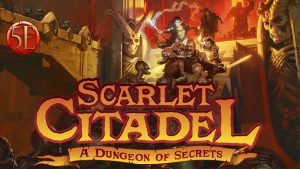
When asked on the DM’s Deep Dive podcast what his highest expectations were for someone taking something like the Midgard Worldbook and bringing it into their home game, Kobold-in-Chief Wolfgang Baur replied, “My highest expectation for Midgard is someone will strip it for parts.”
In that spirit, this series examines how and why we might take published adventures and, rather than running them as written, take them apart and repurpose pieces for our home games.
First, we’ll address the general concept, and then we’ll go through Kobold Press’s 5E megadungeon adventure, Scarlet Citadel to find elements to extract and repurpose. Along the way we’ll develop a sense of what to look for and how to remove and reuse these bits at your table.
Ye Olde Adventure Modules
The first RPG scenarios were commonly referred to as adventure “modules” because they were intended to be dropped into campaigns in a modular way. A smaller scale of lore was helpful for the purpose of modularity, limited to hazy historical events or the names of deities.
Locations like the steading of the hill giant chief and the village of Orlane were largely self-contained. Any ties to Gary Gygax’s Greyhawk setting could be ignored easily to be placed in your own home setting instead. All you really needed were some hills in the wilderness or a trade route that ran by a swamp.
In time, adventure narrative design became more ambitious, aiming to tell grand stories that could encapsulate an entire campaign. Adventure paths rose to prominence, taking characters from creation to retirement, with thematic story connections throughout. While the independent units of an adventure path could be run independently, the richest experience was in lining them up into a longer storyline.
The Campaign Adventure
The evolution from adventure path to modern campaign adventure book is a pretty straight line. An adventure like Empire of the Ghouls takes characters from 1st to 13th level, from a small town to the darkness of the underworld, telling a story that grows in scope with the characters’ advancement.
While campaign adventures offer rich experiences, they can be real commitments! Most take between six and eighteen months to run from beginning to end, and everyone needs to buy in that this is the adventure, lest someone burn down the inn where the essential quest giver is staying, leaving the GM scrambling to get to the next chapter.
While the ties between units of a campaign adventure might be more robust than those of a serialized adventure path, they can still be cut and reconnected to relevant features of your ongoing game.
Parts is Parts
Everything in an adventure is fair game for reuse. Once it’s in your hands, chop it up however you like. (There’s usually an element of this anyway, as no two tables play through an adventure in the exact same way.)
Perhaps the adventure has an aspect you don’t care for, or you don’t feel works well for your group or your GMing style. So you adapt it.
Or it’s possible that your players forgot the social contract and burned down the inn after all. Having been run out of town by the local authorities, they have to get the next quest hook from a hermit in the woods rather than the noble waiting for them at the Griffin’s Arms. In this case, you’re taking one element out and using another in its place, for the adventure must go on.
What to Repurpose
A number of distinct adventure elements can be repurposed in a modular fashion. Monsters and magic items are the most obvious—you can generally take those out and plop them anywhere with no extra work.
Adventure locations are only slightly more complex. One castle or cave is as good as another in most cases. You could just take the map. Do you want the traps and combat encounters as well? Take as much or as little as you like!
Minion monsters are often pretty interchangeable. Ratfolk can swap out for kobolds, for instance. They have the same challenge rating and similar pack tactics. The flavor of the encounter can follow with the change. Perhaps it inspires a new story twist given the lore differences between kobolds and ratfolk.
An NPC might be desirable because of their description, stat block, schemes, or unique mechanics. NPCs can be trickier to repurpose, as they are often defined by their connections to an adventure. But with a little careful substitution, they can be transplanted to your table. Everything is fair game, and with a little careful inspection and consideration.
Next Session
Next time we’ll begin our journey into the Scarlet Citadel to get a sense of what to pull from its depths.
